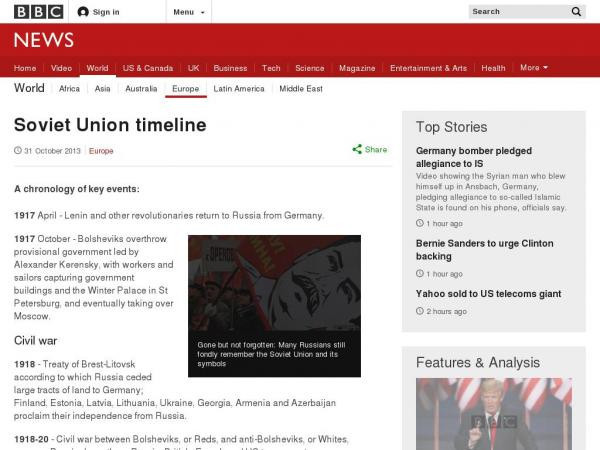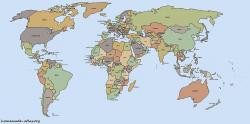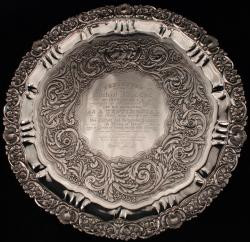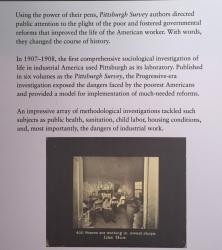Kate Harris
Social Studies teacher
Pittsburgh CAPA
Middle School (13 to 15 years old), High School (16 to 18 years old)
Teacher/Educator
Language Arts And English, Civics, Literature, Cultures, Economics, Social Studies, Geography, Writing, US History, Arts, Other
I'm a history-lover, art fan, and bookworm. I taught high school history (U.S. History and World Religions) for ten years in North Carolina, teach currently in Pittsburgh, PA, and am working to help teachers make the most of this new resource!
Kate Harris's collections
The Art of Writing and Calligraphy
This collection includes a variety of resources representing styles of writing from around the world. It encourages viewers to consider writing not only for its ability to communicate through letters and symbols, but also for its artistic value. The collection includes a video on Sumerian writing, a website on African writing systems and art, and artifacts that are examples of the writing of East Asian, Arabic, Cherokee, Hebrew, and Modern European alphabets. In addition, a few tools used for writing are included. There is some background material on each type of writing as you read through the collection.
Questions for classroom discussion and research might include:
-What is the purpose of writing? Why use hand-writing or calligraphy instead of using a computer?
-How do alphabets differ?
-How can a style of calligraphy (or font change) the interpretation of a written work?
 Kate Harris
Kate Harris
29
The Black Arts Movement
<p>"On the relationship between the Black Power and Black Arts movements, Larry Neal writes, “Black Art is the aesthetic and spiritual sister of the Black Power concept. … The Black Arts and the Black Power concept both related broadly to the Afro-American’s desire for self-determination and nationhood.” The artists within the Black Arts movement sought to create politically engaged work that explored the African American cultural and historical experience and transformed the way African Americans were portrayed in literature and the arts."</p>
<p>This topical collection includes background information as well as examples of poetry and art from the Black Arts Movement. Two excerpts from essays are also included. There are also some examples of works from artists who rejected the premise of the Black Arts Movement. </p>
<p>Students could use this collection as a starting point for further research or to create an illustrated timeline of the movement. Works could be analyzed for their reflection or rejection of themes like: black nationalism, self-determination, "the black is beautiful" movement, and liberation. Students could also evaluate the merits of the arguments for and against a "black arts movement" as articulated by Karenga and Saunders in the text excerpts.</p>
<p>This is a work-in-progress based on the digitized materials within the Smithsonian Learning Lab's collection--it is not meant to be wholly definitive or authoritative.<br /></p>
 Kate Harris
Kate Harris
39
The Black Power Movement
<p>Teaching about the Black Power Movement can be challenging, but has rich rewards. Misconceptions about the Black Power Movement abound, but the ability to contrast their strategies and aims with the earlier Civil Rights Movement allows Social Studies teachers to discuss the complex ways that social movements evolve, change, and respond to the times. In addition, a study of the Black Power Movement helps give context for a broader study of the economic and political shifts in the 1970s and 1980s and the rise of identity politics. This teaching collection includes a variety of resources that could be used to teach about the Black Power Movement, organized into sections for:</p><p>-People in the Movement</p><p>-Goals and Strategies of the Movement</p><p>-Teaching Activities</p><p>General guiding questions for this collection include:</p><p>-What were the distinct problems that the Black Power Movement tried to address? Do they remain today?</p><p>-What were the strategies of the Black Power Movement? Do you agree or disagree with these? </p><p>-Why and how do social movements develop and evolve? </p><p>-What defines a successful social movement? Was the Black Power Movement successful?</p><p>- Can a social movement survive beyond the demise of its leadership?</p><p>-What is the role of the arts in promoting the ideals of social movements?</p><p>This is a work-in-progress based on the digitized materials within the Smithsonian Learning Lab's collection--it is not meant to be wholly definitive or authoritative.<br /></p>
 Kate Harris
Kate Harris
31
The End of the Cold War
This teaching collection chronicles the events and people associated with the end of the Cold War. Suggested teaching strategies are embedded throughout.
Guiding questions include:
-Who started the "revolutions" of 1989--Gorbachev and his reforms? People in Eastern Europe?
-Evaluate the roles of the United States and the Reagan and Bush administrations, as well as the changes within the Soviet Union, in bringing about the end of the Cold War.
-Why did the Cold War end?
-What were the costs of the Cold War, both human and material?
-What are the legacies/lessons of the Cold War?
-What uncertainties or questions remained as the Cold War came to a close? What would come to characterize the 'New World Order' that followed?
Tags: Wilson Center, Cold War, Reagan, Gorbachev, glasnost, perestroika, revolution, Soviet Union, USSR, Communism
 Kate Harris
Kate Harris
21
The End of World War I
This collection asks users to consider how unresolved issues from WWI may have led to the outbreak of war again in the 1930s. Included is a letter from a soldier on the end of the war, a summary of the Treaty of Versailles, a painting and a political cartoon.
The collection asks students to evaluate the predictions about future wars made by the letter's author and then to evaluate how and why the Treaty of Versailles may have failed.
Tags: World War I, Treaty of Versailles, League of Nations, armistice, interwar, World War I, Hitler
 Kate Harris
Kate Harris
5
The Fight to End Apartheid
<p>This is a topical collection of resources related to the fight to end apartheid. Teachers and students can use this collection to explore strategies used to fight against apartheid as well as famous leaders in the fight. Strategies include economic sanctions, boycotts, and divestment, raising awareness through artists and musicians, nonviolent protest, armed resistance, and external political pressures on the South African government. This is a work-in-progress based on the digitized materials within the Smithsonian Learning Lab's collection--it is not meant to be wholly definitive or authoritative. Think of it as a starting point for further inquiry!</p><p>Possible student activities include:</p><p>-researching one strategy of resistance and/or one well-known leader in depth.</p><p>-drawing comparisons between political organizations and movements like the ANC, PAC, Black Consciousness Movement, and United Democratic Front.</p><p>-creating a timeline of resistance to apartheid.</p><p>-debating the use of armed resistance and "sabotage."</p><p>-interviewing adults who may remember the end of apartheid.</p><p>-drawing comparisons between the civil rights movement in the United States and the anti-apartheid movement.</p><p>-choose 1-3 events and make a case for them as turning points in the fight against apartheid. What makes these events so significant?</p><p>tags: apartheid, South Africa, Mandela, Tutu, Huddleston, Soweto, townships, Sharpeville, Defiance Campaign, Biko</p>
 Kate Harris
Kate Harris
28
The March on Washington
The Civil Rights Movement of the 1950s and 60s tackled many problems facing African-Americans at the time. This collection offers a brief video introduction into the March on Washington in 1963, which brought national attention to many of these issues, and asks students to analyze a photograph and three artifacts from the March. Students will answer the question "What problems did participants in the March on Washington aim to solve?" and consider how these issues continue to have relevance in the United States today.
tags: Civil Rights, Martin Luther King, A. Phillip Randolph
 Kate Harris
Kate Harris
6
The Maya People Today
This collection includes many videos, in English and Spanish, and resources showing how the Mayan people living today have preserved their traditions while adjusting to modern life. Students can use the collection to learn about the values and traditions that remain important in Mayan life today.
Those who want to learn more about the ancient Maya should view this collection:
https://learninglab.si.edu/collections/the-achievements-of-ancient-mayan-civilization/Cb7G8r7LdVF6mGqm
 Kate Harris
Kate Harris
23
The Melting Pot at the United Shoe Machinery Corporation
<p>This student activity includes a set of archival documents from the United Shoe Machinery Corporation. These documents can be used as resources to help students investigate the relationship between industry, education, and immigration in the early 20th century. </p><p>As students explore the collection, they should consider how each document helps them answer the following questions:</p><p>-Is it in the best interests of business to encourage citizenship and education? Why or why not?</p><p>-What do these materials say about what it means to be considered "American" in the early 20th century?</p><p>tags: school, learning, English, language, migration, Ellis Island, manufacturing, Progressives</p>
 Kate Harris
Kate Harris
8
The Mughal Empire
<p>What is the role of art and culture in the expansion of nations or empires? This collection traces the general history of the Mughal Empire and its influence on Indian art. The Mughals were a dynasty of Islamic leaders who conquered India in the 16th and 17th centuries. Their blend of influences and the stylistic preferences of the emperors created a distinct style. </p><p>Guiding questions to consider are:</p><p>How did the Mughals assert their authority over and create a sense of unity within India?</p><p>Why is art so important to powerful leaders, and how can they influence artistic styles?</p><p>Tags: religion, culture, syncretism, Islam, Muslim, India, Hindu, cause effect, chronology</p>
 Kate Harris
Kate Harris
14
The Olympics and the Cold War
This learner resource includes artifacts and archival documents regarding the 1980, 1984, and 1988 Olympics. Students will explore these materials in order to develop an understanding of how the Olympics were used as a platform for the United States and the Soviet Union to display political ideals during the Cold War. Comprehension and analysis questions are embedded throughout.
Tags: Wilson Center, Cold War, Olympics, hockey, Miracle on Ice, boycott, Afghanistan, Soviet Union, USSR, Communism
 Kate Harris
Kate Harris
10
The Pittsburgh Survey
<p>This topical collection contains resources related to the <a href="https://en.wikipedia.org/wiki/The_Pittsburgh_Survey" target="_blank">Pittsburgh Survey</a>, a groundbreaking Progressive Era research study of the living and working conditions in turn-of-the-century Pittsburgh. This study, published in books and magazines, led to the passage of worker-safety laws and encouraged other Progressive Era reforms. The images, readings, and links to archival materials in this collection can be used to support exploration of the questions below.</p><p>Guiding Questions:</p><ul><li>In what way did the Pittsburgh Survey reflect Progressive Era concerns, strategies, and achievements?</li><li>How did Progressive Era beliefs about social change differ from those held previously?</li></ul><p>Tags: Progressives, child labor, worker safety, scientific management, muckrakers, reform movement, Lewis Hine, Paul Kellogg, Crystal Eastman. Joseph Stella, Homestead, Pittsburgh, Pennsylvania</p>
 Kate Harris
Kate Harris
13











